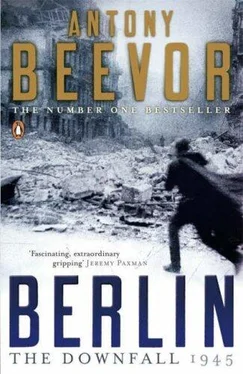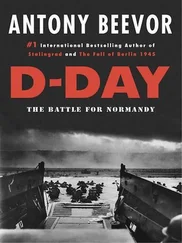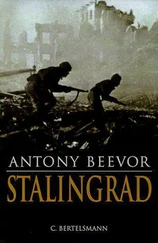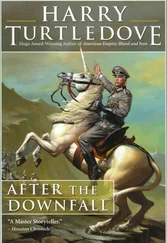Most menacing of all was the wave of executions carried out by the SS on Himmler’s orders. On 23 January, with the Red Army now breaching the old frontiers of the Reich, several members of the German resistance linked to the July plot were put to death in Plötzensee prison. The victims included Count Helmuth James von Moltke, Eugen Bolz and Erwin Planck, the son of the Nobel Prize-winning physicist Max Planck.
Goebbels’s new slogan, ‘We shall win, because we must win’, provoked contempt and despair among non-Nazis, but the majority of Germans did not yet think to question it. Even though only fanatics now believed in ‘final victory’, most still held on because they could not imagine anything else. The strategy of Goebbels’s relentless propaganda, ever since the war in the east turned against Germany, had been to undermine any notion of choice or alternative.
Goebbels, as both Reich Commissar for the Defence of Berlin and minister for propaganda, appeared in his element as chief advocate of total warfare: visiting troops, making speeches, reviewing Volkssturm parades and haranguing them. The population at large saw nothing of Hitler. He had disappeared from the newsreels, and they heard only Hitler’s very last broadcast on 30 January, marking twelve years of Nazi government. His voice had lost all its strength and sounded completely different. It was hardly surprising that so many rumours circulated about his death or confinement. The public was not told whether he was at Berchtesgaden or in Berlin. And while Goebbels visited the victims of bombing, gaining considerable popularity as a result, Hitler refused even to look at his severely damaged capital.
The Führer’s invisibility was due partly to his own withdrawal from public life and partly to the difficulty of concealing the dramatic changes in his appearance. Staff officers visiting the Reich Chancellery bunker who had not seen him since before the 20 July bomb explosion were shaken. ‘He was sometimes hunched over so much,’ said Guderian’s aide, Major Freytag von Loringhoven, ‘that he almost had a hump.’ The once glittering eyes were dull, the pale skin now had a grey tinge. He dragged his left leg behind him on entering the conference room and his handshake was limp. Hitler often held his left hand with his right in an attempt to conceal its trembling. Still just short of his fifty-sixth birthday, the Führer had the air and appearance of a senile old man. He had also lost his astonishing grasp of detail and statistics, with which he used to batter doubters into submission. And he no longer received any pleasure from playing followers off against each other. Now, he saw treason all around him.
Officers of the general staff were all too aware of the anti-army atmosphere when they visited the Reich Chancellery bunker each day from Zossen. Guderian’s arrival in his large staff Mercedes was greeted by SS sentries presenting arms, but once inside, he and his aides had to offer up their briefcases to be searched. Their pistols were taken from them and they had to stand while SS guards examined the line of their uniform with a practised eye, searching for suspicious bulges.
Army officers also had to remind themselves before entering the Reich Chancellery that saluting in the traditional manner had now been banned. All members of the Wehrmacht had to use the ‘German greeting’, as the Nazi salute was known. Many found themselves raising their hand to the cap, then suddenly having to shoot the whole arm outwards. Freytag von Loringhoven, for example, was not in the most comfortable of positions in such surroundings. His predecessor had been hanged as part of the July plot, and his cousin Colonel Baron Freytag von Loringhoven, another conspirator, had committed suicide.
The Reich Chancellery was almost bare. Paintings, tapestries and furniture had been removed. There were huge cracks in the ceilings, smashed windows were boarded up and plywood partitions concealed the worst of the bomb damage. Not long before, in one of the huge marble corridors leading to the situation room, Freytag had been surprised to see two expensively dressed young women with permed hair. Such elegant frivolity seemed so out of place in the surroundings that he had turned to his companion, Keitel’s adjutant, to ask who they were.
‘That was Eva Braun.’
‘Who’s Eva Braun?’ he asked.
‘She’s the Führer’s mistress.’ Keitel’s adjutant smiled at his amazement. ‘And that was her sister, who’s married to Fegelein.’ The Wehrmacht officers attached to the Reich Chancellery had remained completely discreet. Hardly anyone outside had ever heard of her, even those who visited the place regularly from the army high command headquarters at Zossen.
Freytag certainly knew Fegelein, Himmler’s liaison officer. He thought him ‘a dreadful vulgarian with a terrible Munich accent, an arrogant air and bad manners’. Fegelein used to interrupt generals in mid-conversation, trying to involve himself in everything. But despite his intense dislike, Freytag summoned up his courage to ask a favour. A friend of his had been one of the many arrested in the wake of the July plot and was still held in the cellars of Gestapo headquarters. He told Fegelein that he was virtually certain that his friend had had nothing to do with the conspiracy, and asked if he could at least find out what charges were being laid against him. To his surprise, Fegelein agreed to look into it and his friend was released shortly afterwards.
Fegelein, an SS cavalry commander who had won the Knight’s Cross fighting partisans in Yugoslavia, was enamoured of his own rather louche good looks. He clearly enjoyed using his massive influence, which came partly from his position as Himmler’s representative and partly from his proximity to the Führer. He had become very close to Eva Braun, with whom he danced and rode. Some suspected an affair between them, but this was unlikely. She was genuinely devoted to Hitler, while he was probably too ambitious to risk a dalliance with the Führer’s mistress. On 3 June 1944, on the eve of the Allied invasion, Hitler had been chief witness at Fegelein’s marriage to Eva’s youngest sister, Gretl. It was the closest anyone could get to a dynastic marriage under National Socialism.
Hitler’s ostensibly military court managed to be both superficially austere and profoundly corrupt at the same time, a contradiction which the rhetoric of self-sacrifice failed to conceal. Incompetence and chaos between competing warlords and party functionaries were cloaked by a false unity of loyalty to their ideological godhead. The mentality of such an assembly, despite all its military uniforms, saluting and twice-daily situation conferences, could not have been further from the reality of the front. And while Hitler’s health visibly deteriorated, intrigues and jockeying for position increased as the Reich crumbled. Göring, Goebbels, Himmler and Bormann all visualized themselves as the Führer’s successor. Perhaps the true measure of the fantasy of Nazi leaders was the very notion that the world might accept any form of succession within the Third Reich, assuming that it had any territory left.
At the end of the third week in January, Marshal Konev’s 1st Ukrainian Front surged into Silesia after the capture of Kraków and Radom. Konev, to preserve the mines and factories of Upper Silesia, as Stalin had instructed, decided to commence a semi-encirclement of the industrial and mining region from Katowice to Ratibor while leaving a route of escape for the German forces left in the area. The 3rd Guards Tank Army had been heading for Breslau but, on Konev’s order, wheeled hard left on the march and came back up along the eastern bank of the Oder towards Oppeln. As if organizing a great shoot, Konev brought up the 21st, 59th and 60th Armies to flush the Germans out.
Читать дальше











